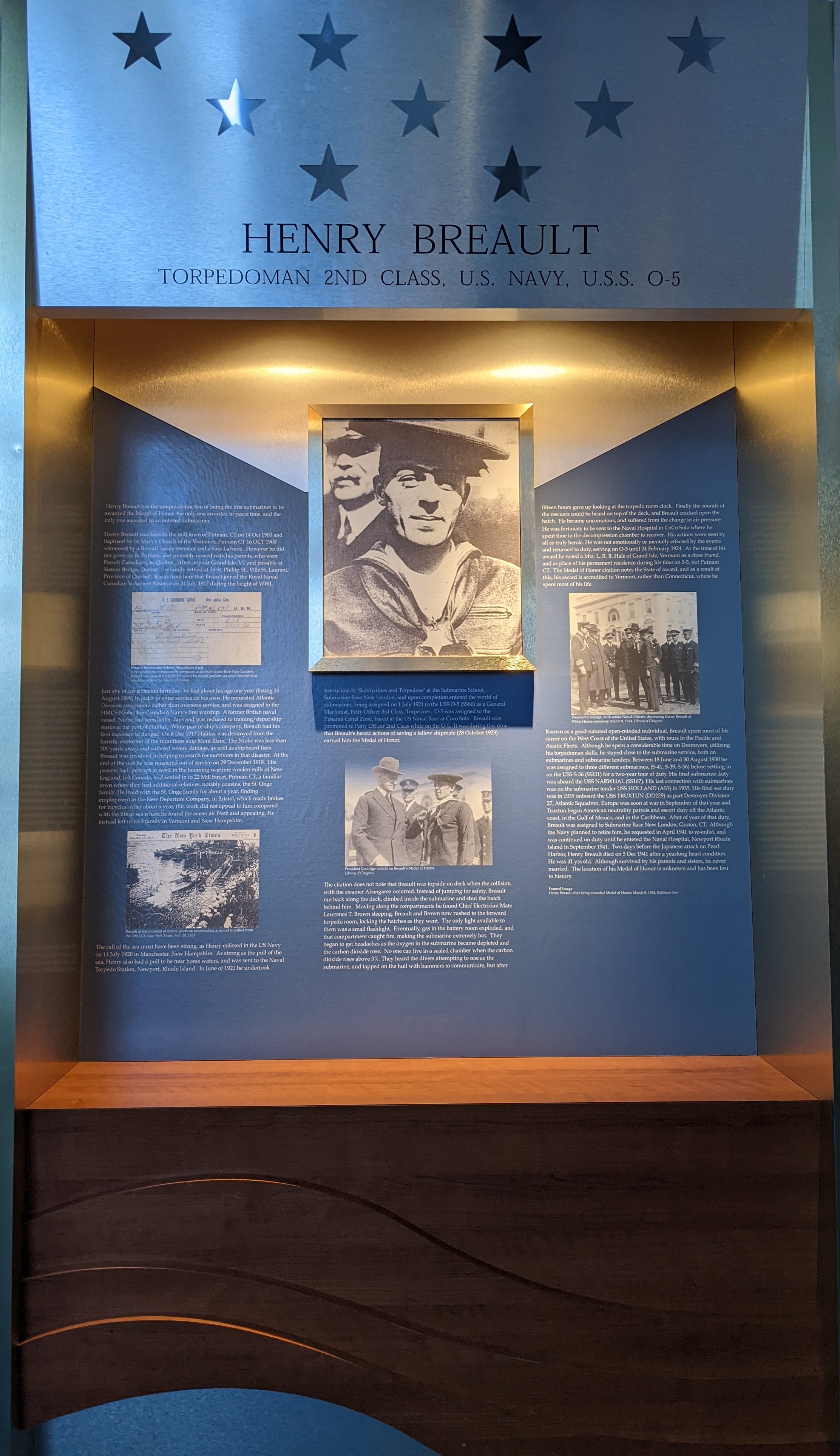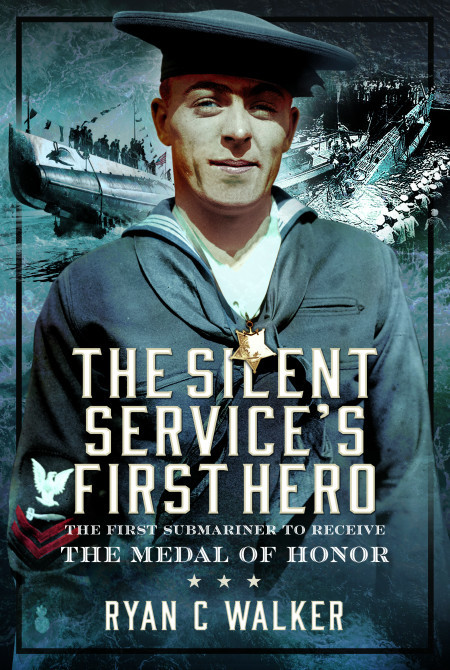Author Guest Post: Ryan C Walker
Why I Devoted a Book Studying Henry Breault’s Life and Times
Do you remember the museum exhibit that made the most impact on you?
As a historian, I frequent museums and enjoy their exhibits. I always have, even before I knew I was becoming a historian. But the museum that is nearest and dearest to my heart is the Submarine Force Library and Museum (SFLM), located in Groton, CT. I first visited the SFLM in 2015 as a freshly arrived graduate from USN Recruit Training Command. I had reported for the first of my schools, known as Basic Enlisted Submarine School, where one of the assignments was to visit the SFLM. To verify that we had actually done so, a scavenger hunt was created, asking questions to ensure we took our time understanding our history.
I went with a group of friends, excited that visiting a museum was an actual assignment. The final question on the list read (not verbatim), who is the only enlisted submariner to receive the Medal of Honor? In the Medal of Honor section located before the door to the Nautilus, I saw the exhibit that would impact me profoundly.

The sailor staring back at me from under the flat-hat so common before the dixie cup had a slight smile. Due to him looking at the camera when the picture was taken, it felt like he was looking at me. The museum exhibit connected me to the past I was inheriting as an aspiring submariner. Little did I know at the time, the Breault Exhibit would inspire me to write what eventually would become a book.
Walking around the SFLM is an experience I highly recommend. The observant visitor will see numerous representations of enlisted submariners, ranging from the mannequins in dungarees performing their duties on the Nautilus to pictures of submariners playing poker while underway. There is no shortage of representation, but the only enlisted submariner to have a full exhibit dedicated to them is… Henry Breault. The Squalus survivors are recognized, and numerous others are mentioned, but none together like Breault. For many like myself, Henry Breault became the face of enlisted submariners, particularly considering the small size of the submarine force guarantees few in the US know an enlisted submariner. As the representment of the enlisted submariner, this is the best chance for our story to be introduced, and as such I have attempted to reconstruct his life to the best of my ability.
While submariners recognize the importance of the subject, why does an entire book, largely analytical, need to be written about his life and times? In short, why should you care?
As a Medal of Honor recipient, Breault is one of 3516.[1] I would like to say this alone is merit enough, but the truth is there are other recipients who remain largely forgotten or have not received historical analysis. Further, The Silent Service’s First Hero (TSSFH) is not a hagiography nor a biography, it is an analytical microhistorical reconstruction. I do devote time to understanding the Medal of Honor in context, but it is not my primary subject. Recognition did not make Breault special, but it did ensure that Breault’s documentation survived and acts as a milestone in Breault’s life.
Instead, this book is an analysis into how an American sailor could live in 1920’s and 1930’s America. Commonly referred to as the Interwar Period, the Roaring Twenties or the Great Depression, none of these macro-terms are sufficient nor accurate. A colleague of mine captured it poignantly, no one in the Interwar period was walking around talking about how they were in the Interwar period.[2] Breault’s life crosses unique periods in their own right and the people that lived in this era had their own ideas on how to live their lives.
TSSFH is an exploration into how Breault sought to live his own life, how he perceived the people around him (and conversely, how they perceived him), and the influences that led to his construction of the world around him. Breault’s viewpoint is unique as a sailor, even one with an important accolade, vacillated between being part of American culture and being on the extreme fringes of it. The American Bluejacket did not have the mainstream appeal of Jack Tar, they were influenced by American society more than they defined it.[3] Further, J. Andrew Byers argues sailors were no longer a distinct social class by 1898, as sailors were increasingly recruited away from port towns and saw their tenure in the USN as a steppingstone to a better career elsewhere.[4]
As their role changed, they existed between worlds, able to observe the trends of their period, participate in them, but also not fully be a part of their home culture as well. Scholars such as James R. Reckner discovered sailors such as Frederick T. Wilson were capable of incredible insight in their personal journals; insights that often hold up today.[5] Numerous memoirs are available, generally related to high-ranking officers and war veterans, but few of these direct personal sources are available for Breault. Could I find new insights utilizing his impersonal documentation?
In TSSFH, the task was accomplished by exploring the full picture of Breault, as an individual self-portrait, the socio-cultural context that acts as a group-portrait, then how the two interact and reinforce one another.[6] In this case, I utilize a methodology I call mosaic microhistory, where the constituent pieces alone are difficult to discern. Combined with a wide range of sources, we create a mosaic of Breault that incorporates a wide range of primary and secondary sources. Breault did not exist alone, he was subject to the same pressures of his peers and studying his relationship and sense of self will offer more insight in the submariner of the Interwar Navy.
[1]. The Medal of Honor Museum, “The Medal,” accessed August 25, 2023, https://mohmuseum.org/the-medal/.
[2]. I think many of us have had similar thoughts, but I must thank fellow Portsmouth student Paul O’Donnell for the exact statement.
[3]. Mary A. Conley, From Jack Tar to Union Jack: Representing Naval Manhood in the British Empire, 1870–1918, (Manchester: Manchester University Press, 2017), 1-5, 127; Mary A. Conley, “You Don’t Make a Torpedo Gunner Out of a Drunkard:’ Agnes Weston, Temperance, and the British Navy,” The Northern Mariner/Le Marin du nord, IX, No. 1 (January 1999), 1-2; Joanne Begatio. “Tears and the manly sailor in England: c. 1760–1860,” Journal for Maritime Research, 17, (2015): 119, https://doi.org/10.1080/21533369.2015.1094981.
[4]. J. Andrew Byers. “The Sailors of 1898: Identity, Motivations, and Experiences of Naval Enlisted Personnel at the Dawn of an Age of American Empire,” International Journal of Naval History 7 (August 2008): 12, https://www.ijnhonline.org/wp-content/uploads/2012/01/Byers.pdf.
See also: James R. Reckner, “The Men Behind the Guns’ The Impact of the War with Spain on the Navy Enlisted Force.” In Theodore Roosevelt, the US Navy, and the Spanish-American War, (New York: Palgrave Macmillan US, 2001), 96.
[5]. James R. Reckner, Sailor’s Log: Water-Tender Frederick T. Wilson, USN, on Asiatic Station, 1899-1901, (Kent: Kent State University Press, 2013).
[6]. Carlo Ginzburg, Clues, Myths, and the Historical Method, trans. John and Anne Tedeschi, (Baltimore: John Hopkins University Press, 1989), 34. I take inspiration from Carlo Ginzburg for the self and group portrait metaphors, who in turn borrowed from fellow historian Giovanni Levi.

The Silent Service’s First Hero will be published in 2024.

